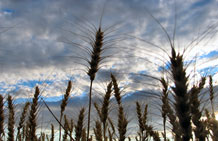
Organic fields of wheat.
Future of organic farming
New evidence on the problems and prospects for organic farming is revealed in a major report for the Department for Environment, Food and Rural Affairs (DEFRA).
For the first time an integrated analysis of organic farming focusing on all three areas of marketing, consumer behaviour and production has been conducted.
The University of Exeter’s Centre for Rural Policy Research led the substantive report co-authored by the Countryside and Community Research Institute at the University of Gloucestershire.
The socio-economic impact of organic farming on rural areas has its limitations according to findings in the report. Despite impressive growth in recent years, food production by organic farmers is still relatively small compared to other sectors of agriculture in England and Wales. As a result, the report suggests that organic production does not offer policy makers a broad enough platform to launch rural development polices. However, it does argue that organic production involving large numbers of small locally embedded producers is, nonetheless likely to be beneficial to rural economies, albeit in geographically uneven ways.
The report, based on a survey of over 21% of all organic farm land in England and Wales, indicates that a predominance of large scale farms which supply national markets, such as supermarkets, are located in Wales, the North East and the East and West Midlands. Farms in the North West and Yorkshire and Humberside tend to focus more on their regional markets. A large number of smaller farms are concentrated in the South East, South West and the Eastern region and are strongly orientated towards selling to their local market through box schemes, own farm shop and farmers’ markets etc. This group of producers, locally embedded and linked to consumers via short supply chains, fulfil the expectations of many organic consumers and exemplify the idea of alternative food producers.
University of Exeter rural expert, Dr Matt Lobley said, ‘Those farms focusing on local markets accounted for just under 35% of all producers but only 13.7% of all sales, while those with an orientation more towards national markets accounted for 37% of all farms but over 50% of all sales. Although a local market orientation is important in terms of the number of producers involved, in terms of its contribution to aggregate sales income it is much less important.’
He added, ‘The organic sector is unevenly split, with the largest 10% of farms accounting for over half of the sales and half of the full time staff employed.’
Findings in the report illustrate that small, locally embedded producers can benefit the rural economy. The study argues that as business people, organic producers are more likely to be willing to diversify their operations and enter into innovative marketing arrangements in ways which not only generate more employment overall but also employ a greater proportion of non family workers on their farms. The report identified a group of highly committed, typically small scale and locally orientated, organic producers who manage a more diverse range of marketing channels compared to those with a more national and regional market focus. However, the larger organic operators engaged in bulk commodity production are able to draw income into the rural economy through marketing to wholesalers and processors.
The report identifies a number of concerns voiced by organic producers. Professor Brian Ilbery of the University of Gloucestershire explained, ‘Many of the organic farmers we spoke to in England and Wales were concerned about the cost and availability of primary organic inputs such as feed and seed. Not only were these inputs often not available locally, but the necessary proteins and soya needed by organic livestock were in short supply both nationally and internationally.’
He went on to say that ‘There are problems with direct marketing and/or adding value activities. These include competition in box schemes from supermarket chains and national suppliers, combined with the difficulty of adding value locally in regions with limited demand for organic food. There is also a shortage of processing capacity, which means that for some producers the future seemed to be about producing more for the main organic commodity markets, with a national rather than local sphere of influence.’
The report also provides evidence of a healthy future for organic farming, identifying a general trend towards increasing areas farmed over the coming years, adding more marketing channels and increasing on-farm processing. As a consequence of this, employment is likely to increase in some rural areas through adding value to their output through retailing, packaging or distributing their produce. Farmers that add value to their produce have a more diverse marketing approach to selling their organic produce and are typically more local in market focus.
Dr Matt Lobley of the University of Exeter said, ‘Over half of the farmers surveyed said they would continue in organic production as long as they can continue to make a profit. Interestingly, it is often the smaller, more locally orientated farmers that said they will only ever farm organically.
He added, ‘A third of farmers did not expect their sales orientation to change over the coming five years, some hoped to increase their sales at the farm gate, in farm shops, to local butchers and wholesale to local catering establishments and retail outlets. Others indicated that they are attempting to survive by selling organic produce into the conventional market.’
See the Analysis of socio-economic aspects of local and national organic farming markets Executive summary and Summary report for more information.
Date: 19 October 2009
